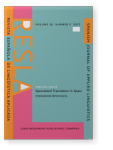The audio describer as a cultural mediator
Audio Description (AD) is a modality of audiovisual translation that consists of making cultural products accessible to people who are blind or partially-sighted. Our study focuses on the contrastive analysis of the AD of four films in English and Spanish, our objective being to determine how the same visual cultural reference is described in two languages and for two target cultures. Using a descriptive methodology, we categorise and analyse cultural references following
Díaz Cintas and Remael’s (2007) classification and determine the translation strategies used. Our research shows that the decisions that the describer makes are conditioned by the distance, not only geographical but above all cultural, that exists between the audience and the culture that is reflected in the film. The describer becomes a mediator between cultures; that is why the greater the cultural distance, the higher their presence and involvement.
Article outline
- 1.Introduction
- 2.The profile of the describer
- 3.Cultural references and AD
- 4.Descriptive comparative analysis of the AD of cultural references
- 4.1Quantitative analysis of strategies used in the AD of cultural references
- 4.2Qualitative analysis of the AD of cultural references
- 4.2.1Geographical references
- 4.2.2Ethnographic references
- 4.2.2.1Art and popular culture
- 4.2.2.2Religion
- 4.2.2.3Food and drink
- 4.2.2.4Clothing
- 4.2.2.5Transport
- 4.2.3Socio-political references
- 5.Conclusions
- Notes
-
References
References (38)
References
AENOR (2005). Norma UNE 153020: Audiodescripción para personas con discapacidad visual. Requisitos para la audiodescripción y elaboración de audioguías. Madrid: AENOR.
Agost, R. (1999). Traducción y doblaje: Palabras, voces e imágenes. Barcelona: Ariel.
Arndt, M. (2007).
Themes of Little Miss Sunshine. Fora TV. Retrieved from [URL]. [Accessed: 03.09.16].
Atwood, C. (2005). The costumes of Memoirs of a geisha
. Retrieved from [URL] [Accessed 14.09.16]
Arma, S. (2012). Why can’t you hear black shoes like the other mothers?: Preliminary investigation on the Italian language of audio description. In E. Perego (Ed.), Emerging topics in translation: Audio description (pp. 37–55). Trieste: EUT Edizioni Università di Trieste.
Braun, S. (2008). Audiodescription research: State of the art and beyond. Translation Studies in the New Millenium, 61, 14–30.
Chaume, F. (2013). Panorámica de la investigación en traducción para el doblaje. TRANS: Revista de Traductología, 171, 13–34. 

Díaz Cintas, J. (2007). Por una preparación de calidad en accesibilidad audiovisual. TRANS: Revista de Traductología, 111, 45–60.
Díaz Cintas, J. (2008). Introduction. In J. Díaz Cintas (Ed.), The didactics of audiovisual translation (pp. 1–18). Amsterdam/Philadelphia: John Benjamins. 

Díaz Cintas, J., & Remael, A. (2007). Audiovisual translation: Subtitling. Manchester: St Jerome.
Fryer, L. (2016). An introduction to audio description: A practical guide. London: Routledge. 

Fuentes Luque, A. (2001). Consideraciones sobre la traducción de referencias culturales subordinadas. In E. Pajares, R. Merino, & S. M. Santamaría (Eds.), Trasvases culturales: Cine, literatura, traducción (pp. 159–166). Vitoria: Servicio Editorial de la Universidad del País Vasco.
García Luque, F. (2009). Translation as a mediating activity: The influence of translation metaphors in research, practice and training of community interpreting. Entreculturas, 11, 647–668.
Hurtado Albir, A. (2001). Traducción y traductología: Introducción a la traductología. Madrid: Cátedra.
ITC. (2000). ITC guidance on standards for audio description. Retrieved from: [URL]. [Accessed 16.09.16]
Jakobson, R. (1959[2004]). On linguistic aspects of translation. In L. Venuti Translation studies reader (2nd Edition) (pp. 113–118). New York: Routledge.
Katan, D. (1999). Translating cultures: An introduction for translators, interpreters and mediators. Manchester: St. Jerome.
Kruger, J. L. (2012). Making meaning in AVT: Eye tracking and viewer construction of narrative. Perspectives, 20(1), 67–86. 

Maszerowska, A., & Mangiron, C. (2014). Strategies for dealing with cultural references in audio description. In A. Maszerowska, A. Matamala, & P. Orero (Eds.), Audio description: New perspectives illustrated (pp. 159–178). Amsterdam: John Benjamins.
Matamala, A., & Rami, N. (2009). Análisis comparativo de la audiodescripción española y alemana de “Good Bye, Lenin!” Hermeneus, 111, 249–266.
Molina, L., & Hurtado Albir, A. (2002). Translation techniques revisited: A dynamic and functionalistic approach. Meta, 47(4), 498–512. 

Navarrete, F. (1997). Sistema AUDESC: El arte de hablar en imágenes. Integración, 231, 70–75.
Pedersen, J. (2005). How is culture rendered in subtitles? In MuTra 2005 – Challenges of multidimensional translation: Conference proceedings. Retrieved from [URL] [accessed 18.01.17]
Pedersen, J. (2009). A subtitler’s guide to translating culture. Multilingual, 103(20), 44–48
Sales Salvador, D. (2004). Puentes sobre el mundo: Cultura, traducción y forma literaria en las narraciones de transculturación de José María Arguedas y Vikram Chandra. Bern: Peter Lang.
Sanderson, J. (2011). Imágenes en palabras: La audiodescripción como generadora de estrategias alternativas de traducción. Puntoycoma, 1231. Retrieved from [URL] [Accessed 16.08.16]
Snyder, J. (2007). Audio description: The visual made verbal. The International Journal of the Arts in Society, 2(2), 99–104.
Szarkowska, A., & Jankowska, A. (2015). Audio describing foreign films. The Journal of Specialised Translation, 231, 243–269.
Taft, R. (1981). The role and personality of the mediator. In S. Bochner (Ed.), The mediating person: Bridges between cultures (pp. 53–58). Cambridge: Schenkman.
Utray, F., Pereira, A. M., & Orero, P. (2009). The present and future of audio description and subtitling for the deaf and hard of hearing in Spain. Meta: Translators’ Journal, 54(2), 248–263. 

Filmography
Goodbye Lenin! (Becker, 2003)
Broken embraces (Almodóvar, 2009)
Inglourious basterds (Tarantino, 2009)
Memoirs of a geisha (Marshall, 2005)
Slumdog millionaire (Boyle, 2008)
Juno (Reitman, 2007)
Little Miss Sunshine (Dayton & Faris, 2006)
Cited by (3)
Cited by three other publications
Wang, Binghui, Deyan Zou & Yanguo Wu
2024.
What to translate and how to translate in audio description: a case study of the Oscar-winning animated film
Feast
.
Media Practice and Education ► pp. 1 ff.

Zajdel, Alicja, Iris Schrijver & Anna Jankowska
2024.
What goes on behind the scenes? Exploring status perceptions, working conditions and job satisfaction of audio describers.
Perspectives ► pp. 1 ff.

Rizzo, Alessandra & Cinzia Giacinta Spinzi
This list is based on CrossRef data as of 22 september 2024. Please note that it may not be complete. Sources presented here have been supplied by the respective publishers.
Any errors therein should be reported to them.
